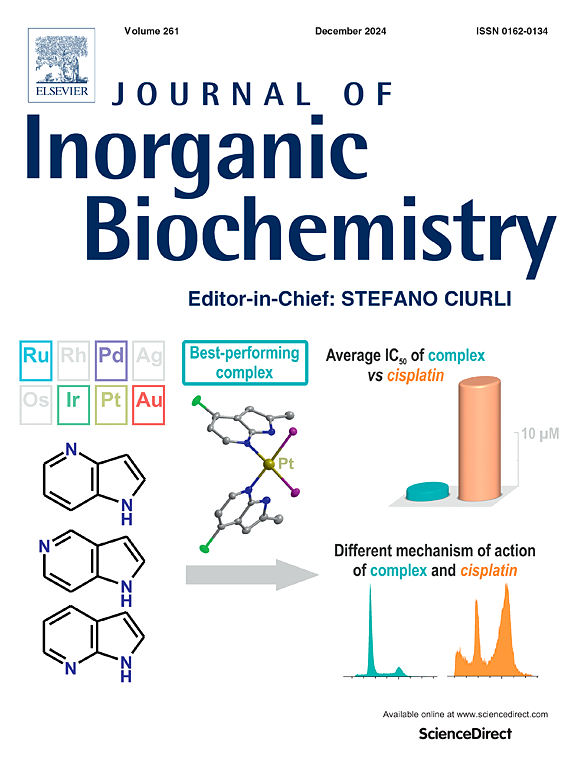利用氧化还原反应的抗癌作用:铜(II)希夫碱络合物通过ROS生成诱导HepG2肝癌细胞凋亡
IF 3.8
2区 化学
Q2 BIOCHEMISTRY & MOLECULAR BIOLOGY
引用次数: 0
摘要
这项研究揭示了铜(II)希夫碱配合物CuL2+进入Cu(I)氧化态并产生活性氧(ROS)的潜力,强调了其在最终治疗应用中的重要性。紫外-可见吸收光谱用于跟踪金属配合物的氧化还原稳定性,也存在还原剂,如抗坏血酸和谷胱甘肽,以及铜(I)螯合剂,二磺酸盐。利用人肿瘤细胞系HepG2(肝癌细胞),我们评估了其降低细胞活力、增加亚g0 /G1细胞比例和启动凋亡途径的功效。细胞活力测定表明,在亚微摩尔浓度下具有明显的剂量依赖性细胞毒性。流式细胞术显示大量ROS产生,随后线粒体膜电位耗散和caspase激活,强调了CuL2+的作用机制。这些发现将CuL2+定位为癌症治疗的有希望的候选者,为铜配合物通过氧化应激和细胞凋亡调节的治疗应用提供了见解。本文章由计算机程序翻译,如有差异,请以英文原文为准。

Harnessing redox reactions for anticancer effects: A copper(II) Schiff base complex induces apoptosis in HepG2 liver cancer cells via ROS generation
This study uncovers the potential of a copper(II) Schiff base complex, CuL2+, to access the Cu(I) oxidation state and generate reactive oxygen species (ROS), highlighting its significance in eventual therapeutic applications. UV–vis absorption spectroscopy was used to follow the redox stability of the metal complex, also in the presence of reducing agents, such as ascorbic acid and glutathione, and of the copper(I) chelator, bathocuproine disulfonate. Utilizing human tumor cell lines HepG2 (hepatocarcinoma cells), we assessed its efficacy in reducing cell viability, increasing the sub-G0/G1 cell fraction, and initiating apoptotic pathways. Cell viability assays demonstrated a dose-dependent cytotoxicity with pronounced effects at sub-micromolar concentrations. Flow cytometry revealed significant ROS production, followed by mitochondrial membrane potential dissipation, and caspase activation, underscoring CuL2+’s mechanism of action. These findings position CuL2+ as a promising candidate for cancer therapy, providing insights into copper complexes' therapeutic application through oxidative stress and apoptosis modulation.
求助全文
通过发布文献求助,成功后即可免费获取论文全文。
去求助
来源期刊

Journal of Inorganic Biochemistry
生物-生化与分子生物学
CiteScore
7.00
自引率
10.30%
发文量
336
审稿时长
41 days
期刊介绍:
The Journal of Inorganic Biochemistry is an established international forum for research in all aspects of Biological Inorganic Chemistry. Original papers of a high scientific level are published in the form of Articles (full length papers), Short Communications, Focused Reviews and Bioinorganic Methods. Topics include: the chemistry, structure and function of metalloenzymes; the interaction of inorganic ions and molecules with proteins and nucleic acids; the synthesis and properties of coordination complexes of biological interest including both structural and functional model systems; the function of metal- containing systems in the regulation of gene expression; the role of metals in medicine; the application of spectroscopic methods to determine the structure of metallobiomolecules; the preparation and characterization of metal-based biomaterials; and related systems. The emphasis of the Journal is on the structure and mechanism of action of metallobiomolecules.
 求助内容:
求助内容: 应助结果提醒方式:
应助结果提醒方式:


